#SAP Master Data Management
Explore tagged Tumblr posts
Text
Maximize the Value of Your Data with Master Data Management

Improve Data Quality with MDM
In today’s competitive business landscape, data has become one of the most valuable assets for any organization. However, data that is inaccurate, incomplete, or inconsistent can cause more harm than good. To harness the full potential of data, enterprises must focus on one critical area: improving data quality with Master Data Management (MDM).
From enabling data-driven decision-making to ensuring compliance and operational efficiency, Master Data Management offers a centralized and consistent view of enterprise data. In this blog, we explore how MDM helps organizations improve data quality, the broader benefits of master data management, and how it integrates with ERP systems for sustainable business outcomes.
Why Data Quality Matters in Today’s Enterprise
Data quality is the foundation of efficient business operations, strategic decisions, and superior customer experiences. Poor data quality leads to revenue loss, reduced productivity, compliance issues, and reputational damage.
For example, duplicate customer records can result in missed sales opportunities or marketing errors. Incorrect product master data may cause supply chain disruptions. The solution? A robust MDM strategy designed to improve data quality across the organization.
How Does MDM Improve Data Quality?
The core objective of MDM is to establish a single, authoritative source of truth for critical data entities—such as customers, products, suppliers, employees, and assets. By centralizing the management of this master data, businesses can:
1. Eliminate Duplicates and Redundancies
MDM tools use matching algorithms and validation rules to identify and merge duplicate records. This ensures that every entity—be it a customer or product—has a single, unified record across all systems.
2. Standardize Data Formats
MDM ensures that data is entered and stored in a consistent format. Whether it's address formats, phone numbers, or part numbers, standardization minimizes discrepancies and makes data easier to interpret and analyze.
3. Enforce Business Rules
MDM platforms allow organizations to define and enforce data entry rules. This includes mandatory fields, data validation checks, and hierarchical relationships between data points. These rules enhance consistency and accuracy.
4. Automate Data Cleansing
Modern MDM solutions offer data cleansing functionalities that correct spelling mistakes, normalize values, and enrich records using internal or external data sources—ensuring high-quality master data at all times.
5. Establish Ownership and Accountability
Through role-based access and workflows, MDM enables data stewardship. Data owners and stewards are responsible for managing the quality, integrity, and lifecycle of master data entities.
By incorporating these functionalities, enterprises can improve data quality with MDM—laying the groundwork for reliable reporting, compliance, and customer satisfaction.
The Broader Benefits of Master Data Management
Beyond improving data quality, there are several other compelling benefits of master data management:
Enhanced Operational Efficiency: Unified data eliminates repetitive manual work and speeds up business processes.
Regulatory Compliance: Accurate and traceable data supports adherence to regulations such as GDPR, HIPAA, and SOX.
Improved Customer Experience: A complete and accurate customer profile enables personalized interactions.
Strategic Decision-Making: Clean, consolidated data improves the reliability of analytics and forecasting.
Cost Reduction: Minimizing errors, rework, and redundant software or database usage leads to significant cost savings.
How to Implement MDM in ERP Systems
One of the most common challenges organizations face is integrating MDM within their existing ERP systems. A successful implementation requires a strategic and phased approach. Here's a high-level guide on how to implement MDM in ERP systems:
Step 1: Identify Master Data Domains
Begin by identifying which data domains (e.g., customer, material, vendor) are most critical to your business processes. Prioritize based on volume, usage, and impact on operations.
Step 2: Conduct a Data Assessment
Profile existing data to assess quality, completeness, and redundancy. Understanding current issues helps in defining cleansing and standardization goals.
Step 3: Select an MDM Platform
Choose a platform that integrates well with your ERP system. For SAP environments, solutions like SAP Master Data Governance (SAP MDG) are ideal. These tools offer pre-built data models and workflows tailored for ERP systems.
Step 4: Define Governance Policies
Establish clear data governance policies, including naming conventions, validation rules, ownership, and data lifecycle management. Assign roles such as data stewards to manage accountability.
Step 5: Cleanse and Migrate Data
Before activating the MDM platform, clean and validate all legacy data. Apply transformation and enrichment rules to standardize records across systems.
Step 6: Enable Ongoing Monitoring
Post-implementation, monitor data quality using KPIs and dashboards. Refine rules and governance policies continuously to ensure ongoing data integrity.
This structured approach helps enterprises effectively integrate MDM into their ERP workflows and maintain data quality over time.
Enterprise MDM Best Practices
To ensure long-term success and scalability, businesses must follow enterprise MDM best practices:
Secure Executive Sponsorship: MDM projects require strong leadership backing and cross-functional involvement.
Align with Business Objectives: MDM should support broader business goals like digital transformation, compliance, or customer 360 initiatives.
Start Small, Scale Fast: Begin with one data domain or business unit. Use early wins to fuel momentum.
Automate Governance: Use workflows, alerts, and approval processes to ensure data accuracy and compliance.
Measure and Improve Continuously: Track improvements in data quality, decision-making speed, and system performance to showcase ROI.
Implementing these practices leads to higher adoption rates, lower resistance to change, and maximum business impact.
SAP MDM Implementation Guide
Organizations using SAP ERP systems have access to one of the most powerful MDM solutions available—SAP Master Data Governance (SAP MDG). Here’s a quick SAP MDM implementation guide to get started:
1. Assess Current Master Data
Understand the data models and usage across your SAP S/4HANA or ECC environment. Identify inconsistencies and opportunities for consolidation.
2. Deploy SAP MDG Modules
SAP MDG offers preconfigured modules for various domains—such as customer, material, and vendor data. Choose modules based on your immediate priorities.
3. Configure Data Models and Workflows
Customize data fields, validation rules, and approval workflows as per business needs. Use SAP Fiori apps for intuitive user experiences.
4. Integrate with SAP BTP
Leverage SAP Business Technology Platform (SAP BTP) for cross-system data orchestration, analytics, and machine learning-based data quality monitoring.
5. Train Teams and Monitor
Ensure all users—from business users to data stewards—are trained on the new data processes. Use built-in analytics to measure data quality improvements over time.
SAP MDG empowers enterprises to manage their master data with transparency, efficiency, and control—leading to better quality data and greater business agility.
Conclusion
Organizations that want to stay ahead in a competitive, data-driven market must make data quality a strategic priority. The ability to improve data quality with MDM is no longer just a technical upgrade—it’s a business imperative.
By implementing a robust MDM solution, aligning it with ERP systems, and following enterprise-grade best practices, businesses can unlock significant value. From better decision-making to smoother operations and enhanced customer satisfaction, the ROI of Master Data Management is undeniable.
At McKinsol, we help enterprises deploy, integrate, and scale MDM solutions—especially in SAP landscapes. Whether you're just starting your MDM journey or seeking to refine your data governance framework, our team offers end-to-end guidance and implementation support.
Let your data work smarter. Contact McKinsol today to maximize the value of your master data.
#master data management#sap mdm#sap solutions#benefits of master data management#sap master data management
0 notes
Text
SAPinsider Event 2025 | NeuVays Brings Expert SAP Solutions

Experience the future of SAP at SAPinsider Event 2025 with NeuVays! Connect with leading SAP experts and discover innovative solutions for SAP License Management, data governance, and digital transformation. Get firsthand insights on best practices, industry trends, and cutting-edge technologies shaping the SAP landscape. Whether you're optimizing SAP systems, improving compliance, or looking for expert guidance, NeuVays is here to help. Join us for interactive sessions, hands-on demos, and networking opportunities at the biggest SAP event of the year!
0 notes
Text
Master data about customers, suppliers, products, profit & cost centres, assets, etc is critical to efficient and effective business processes. If you bring your data problems with you when you move to SAP S/4 HANA implementation you will most likely be disappointed with the quality of your operational and analytical processes once you get there. SAP Master Data Governance is a multi-domain master data management solution that can help you prepare your master data for an SAP S/4HANA implementation.
#sap mm implementation project#sap implementation step by step#master data governance#sap implementation project#sap hana implementation project#sap mm implementatrion interview questions#master data management definition#what is master data management#sap brownfield implementation steps#master data management#what is master data management (mdm)#data migration#implementation complexity#master data management tools#sap pm implementation project
0 notes
Text
intelligentMDG provides a novel approach to SAP Master Data Governance by integrating cutting-edge capabilities with an easy-to-use interface.
#sap master data governance#data governance best practices#data governance consulting#data governance vs data management
1 note
·
View note
Text
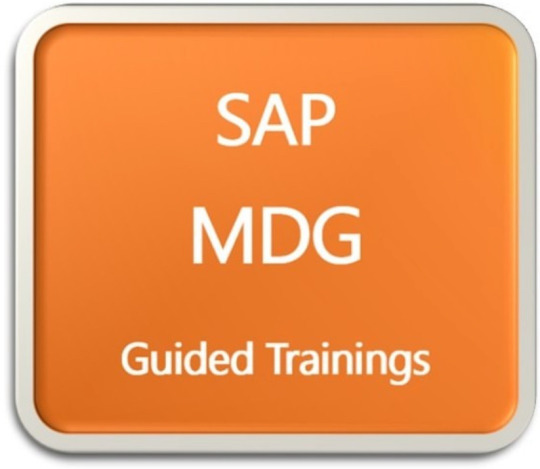
SAP Master Data Governance enables master data to be managed centrally in order to improve data quality, reduce duplicates and consolidate data. This solution makes a valuable contribution to project success during the S/4HANA conversion.
1 note
·
View note
Text
Real Businesses Achieving Success with SAP Solutions
In today’s competitive business environment, organizations must adopt innovative solutions to streamline operations and enhance productivity. Hartmans SAP Consultancy specializes in guiding companies toward success with SAP solutions. These solutions have transformed countless businesses by optimizing processes, improving data management, and empowering employees. In this blog, we will highlight real businesses that have achieved significant success with SAP and explore how SAP Implementation & Integration, Master Data Management, and Advanced SAP Training have played vital roles in their journeys.
The Impact of SAP Solutions
SAP (Systems, Applications, and Products in Data Processing) is a leading enterprise resource planning (ERP) software that integrates various business functions into a cohesive system. By leveraging SAP, organizations can achieve enhanced visibility into their operations, automate repetitive tasks, and make informed decisions based on real-time data. This comprehensive approach not only reduces inefficiencies but also drives growth and innovation.
Case Study: Company A – Streamlined Operations through SAP Implementation
Company A, a mid-sized manufacturing firm, faced challenges with manual processes that hampered productivity and led to errors. Recognizing the need for change, they partnered with Hartmans SAP Consultancy for SAP Implementation & Integration. Our team conducted a thorough assessment of their existing workflows and tailored the SAP system to fit their specific needs.
The implementation resulted in significant improvements. With automated processes and centralized data, Company A reduced production lead times by 30%. Employees could access real-time information, enabling them to respond quickly to customer inquiries and streamline order fulfillment. This transformation not only enhanced operational efficiency but also led to higher customer satisfaction and retention rates.
Case Study: Company B – Mastering Data with MDM
Company B, a retail company, struggled with inconsistent product data across multiple systems, leading to confusion among staff and customers. To address this challenge, they engaged Hartmans SAP Consultancy to enhance their Master Data Management (MDM) practices using SAP solutions.
Through our expertise, Company B established a centralized data governance framework, ensuring that all product information was accurate and consistent across platforms. The result was remarkable. Inventory discrepancies decreased by 40%, and employees could trust the data they used for decision-making. This newfound data integrity enabled Company B to optimize its inventory management and reduce excess stock, resulting in cost savings and improved profitability.
Case Study: Company C – Empowering Employees with Advanced SAP Training
Company C, a financial services firm, recognized that their team needed to enhance their skills to maximize the benefits of their SAP system. They partnered with Hartmans SAP Consultancy to implement Advanced SAP Training programs for their employees.
Our training sessions were designed to meet the varying levels of expertise within the organization. From foundational knowledge for new users to advanced courses on specific SAP functionalities, the training empowered employees to utilize the system effectively. As a result, productivity increased by 25%, and the team was better equipped to leverage SAP’s analytics capabilities for strategic decision-making.
Key Takeaways
The success stories of Company A, Company B, and Company C illustrate the transformative power of SAP solutions. Whether through effective SAP Implementation & Integration, robust Master Data Management, or comprehensive Advanced SAP Training, businesses can unlock the full potential of their SAP systems. Here are some key takeaways for organizations considering SAP solutions:
Invest in Proper Implementation: A well-executed implementation is critical for realizing the benefits of SAP. Engage experts to tailor the system to your specific needs, ensuring seamless integration with existing workflows.
Prioritize Data Management: Maintaining accurate and consistent data is essential for informed decision-making. Implementing strong MDM practices can reduce discrepancies and enhance operational efficiency.
Empower Your Workforce: Continuous training and development are crucial for maximizing the potential of SAP solutions. Investing in employee training fosters confidence and competence, driving productivity and innovation.
Conclusion
SAP solutions have proven to be a game-changer for businesses looking to enhance efficiency, improve data management, and empower their workforce. By partnering with Hartmans SAP Consultancy, organizations can embark on a transformative journey that leads to measurable success.If you’re ready to take your business to the next level with SAP solutions, reach out to us today. Our team of experts is here to guide you through the process of SAP Implementation & Integration, establish effective Master Data Management practices, and provide Advanced SAP Training tailored to your organization’s unique needs. Together, we can achieve remarkable results and set your business on a path to long-term success.
#SAP Consultancy#Master Data Management#Advanced SAP Training#SAP Implementation & Integration#SAP solutions#sap#SAP technology
1 note
·
View note
Text
Precisely Enterworks: A Powerful Alternative to SAP MDM
Accurate and consistent master data is essential for businesses to succeed. Master data management (MDM) solutions help organizations create a single, trusted source of truth for their most critical data, such as customer, product, and supplier information. As organisations move away from monolithic, inflexible architectures, alternatives to SAP MDM are becoming more popular, even amongst SAP…

View On WordPress
0 notes
Text
2024 team sponsors recap!
this is completely irrelevant to F1 but i study and do these stuffs for a living sooo 😩😩 2023 sponsors are based on the sponsors that are there at the beginning of the season (new sponsors that join in the middle of the season will be classified as 2024's)
Mercedes AMG Petronas F1 Team:
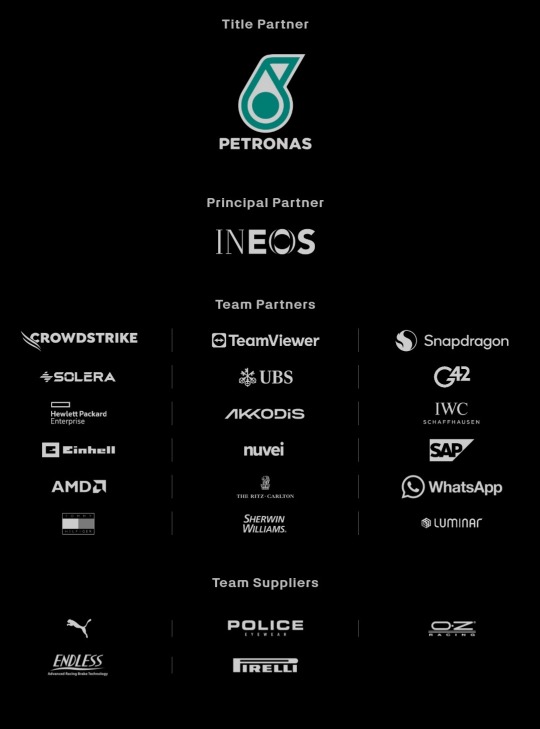
New sponsors: Whatsapp, Luminar (American tech company), SAP (German software company), nuvei (Canadian credit card services), Sherwin Williams (American painting company) 2024 data last update: 2024/02/14
Old sponsors that left: Monster Energy, Pure Storage (American technology company), fastly (American cloud computing services), Axalta (American painting company), Eight sleep (American mattresses company) 2023 data last update: 2023/01/07
Oracle Red Bull Racing F1 Team:
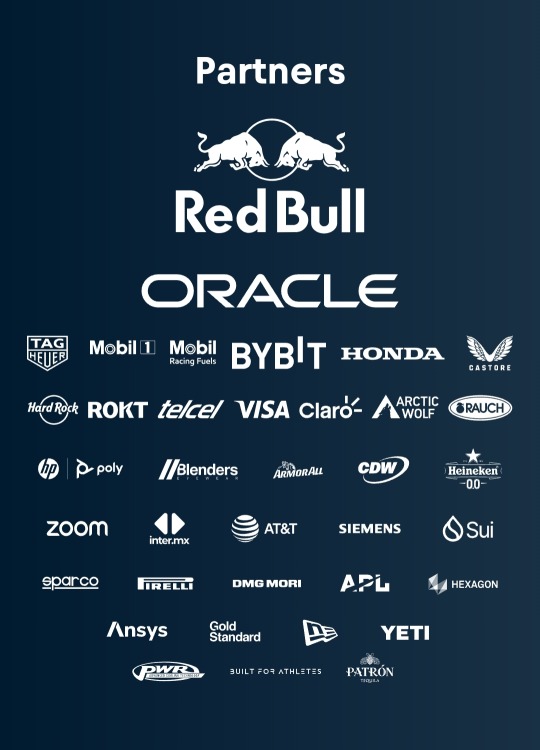
New sponsors: Yeti (American cooler manufacturer, joined later in 2023), APL (American footwear/athletic apparel manufacturer, joined later in 2023), CDW (American IT company, joined later in 2023), Sui (American tech app by Mysten Labs, joined later in 2023), Patron Tequila (Mexican alcoholic beverages company, joined later in 2023) 2024 data last update: 2024/02/15
Old sponsors that left: CashApp, Walmart, Therabody (American wellness technology company), Ocean Bottle (Norwegian reusable bottle manufacturer), PokerStars (Costa Rican gambling site), Alpha Tauri (? no info if they're official partners or not but Austrian clothing company made by Red Bull), BMC (Switzerland bicycle/cycling manufacturer), Esso (American fuel company, subsidiary of ExxonMobil), Hewlett Packard Enterprise (American technology company) 2023 data last update: 2023/03/07
More: Esso is a subsidiary of Mobil so there's possibility they merged or something
Scuderia Ferrari:
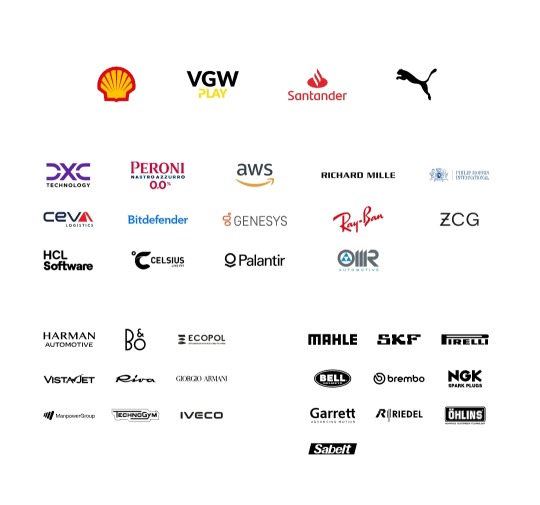
New sponsors: VGW Play (Australian tech game company, joined later in 2023), DXC Technology (American IT company, joined later in 2023), Peroni (Italian brewing company), Z Capital Group/ZCG (American private asset management/merchant bank company), Celsius (Swedish energy drink manufacturer) 2024 data last update: 2024/02/15
Old sponsors that left: Mission Winnow (American content lab by Phillip Morris International aka Marlboro), Estrella Garcia (Spanish alcoholic beverages manufacturer), Frecciarossa (Italian high speed train company) 2023 data last update: 2023/02/16
More: Mission Winnow is a part of Phillip Morris International. They are no longer listed as team sponsor but PMI is listed instead.
(starting here, 2023 data last update is 2023/02/23 and 2024 data last update is 2024/02/15)
McLaren F1 Team: (Only McLaren RACING's data is available idk if some of these are XE/FE team partners but anw..)
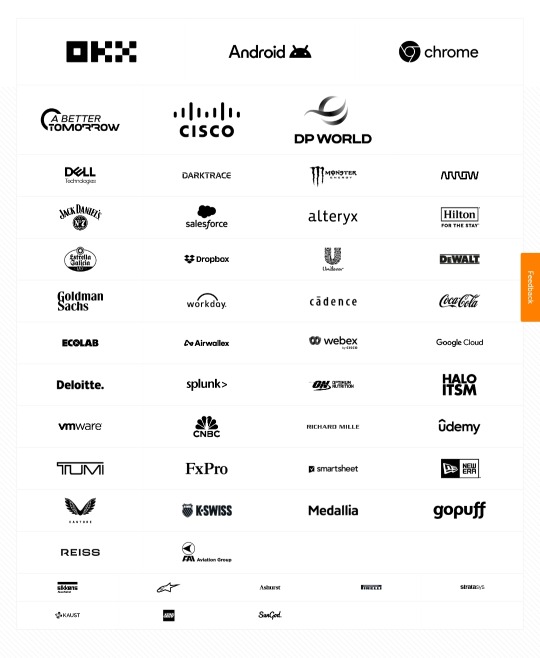
New sponsors: Monster Energy, Salesforce (American cloud based software company, joined later in 2023), Estrella Garcia (Spanish alcoholic beverages manufacturer), Dropbox (American file hosting company), Workday (American system software company, joined later in 2023), Ecolab (American water purification/hygiene company), Airwallex (Australian financial tech company), Optimum Nutrition (American nutritional supplement manufacturer), Halo ITSM (American software company, joined later in 2023), Udemy (American educational tech company, joined later in 2023), New Era (American cap manufacturer, joined in 2023), K-Swiss (American shoes manufacturer, joined later in 2023), Alpinestars (Italian motorsports safety equipment manufacturer)
Old sponsors that left: DP World (Emirati logistics company), EasyPost (American shipping API company), Immersive Labs (UK cybersecurity training company?), Logitech, Mind (UK mental health charity), PartyCasino (UK? online casino site), PartyPoker (American? gambling site), Sparco (Italian auto part & accessory manufacturer), Tezos (Switzerland crypto company)
Aston Martin Aramco F1 Team:

New sponsors: Valvoline (American retail automotives service company, joined later in 2023), NexGen (Canadian sustainable? fuel company), Banco Master (Brazilian digital banking platform, joined later in 2023), ServiceNow (American software company, joined later in 2023), Regent Seven Seas Cruise, Wolfgang Puck (Austrian-American chef and restaurant owner, joined later in 2023), Financial Times (British business newspaper), OMP (Italian racing safety equipment manufacturer), stichd (Netherlands fashion & apparel manufacturer)
Old sponsors that left: Alpinestars (Italian motorsports safety equipment manufacturer), crypto.com (Singaporean cryptocurrency company), ebb3 (UK? software company), Pelmark (UK fashion and apparel manufacturer), Peroni (Italian brewing company), Porto Seguro (Brazilian insurance company), Socios (Malta's blockchain-based platform), XP (Brazilian investment company)
Stake F1 Team (prev. Alfa Romeo):
???? Can't found their website (might be geoblocked in my country???)
BWT Alpine F1 Team:

New sponsors: MNTN (American software company), H. Moser & Cie (Switzerland watch manufacturer), Amazon Music
Old sponsors that left: Bell & Ross (French watch company), Ecowatt (??? afaik French less-energy smthn smthn company), Elysium (French? American? Software company), KX (UK software company), Plug (American electrical equipment manufacturing company)
Visa CashApp RB F1 Team (prev. Scuderia Alpha Tauri):

New Sponsors: Visa, CashApp, Hugo Boss, Tudor, Neft Vodka (Austrian alcoholic beverages company), Piquadro (Italian luxury bag manufacturer)
Old sponsors that left: Buzz (?), Carl Friedrik (UK travel goods manufacturer), Flex Box (Hongkong? shipping containers manufacturer), GMG (Emirati global wellbeing company), RapidAPI (American API company)
Haas F1 Team:

New sponsors: New Era (American cap manufacturer, joined later in 2023)
Old sponsors that left: Hantec Markets (Hongkong capital markets company), OpenSea (American NFT/Crypto company)
Williams Racing:


New sponsors: Komatsu, MyProtein (British bodybuilding supplement), Kraken (American crypto company, joined later in 2023), VAST Data (American tech company), Ingenuity Commerce (UK e-commerce platform), Puma (joined later in 2023)
Old sponsors that left: Acronis (Swiss software company), Bremont (British watch manufacturer), Dtex Systems (American? cybersecurity company), Financial Times (British business newspaper), Jumeirah Hotels & Resorts, KX (UK software company), OMP (Italian racing safety equipment manufacturer), PPG (American painting manufacturer), Umbro (English sports equipment manufacturer), Zeiss (German opticals/optometrics manufacturing company)
#mercedes amg petronas#red bull racing#scuderia ferrari#visa cash app rb#haas f1 team#mclaren f1#aston martin#alpine f1#williams racing#stake f1 team#f1#ari's rant#sponsor talks
42 notes
·
View notes
Text
Mastering Internal Audit: A Comprehensive Guide for Aspiring Auditors
Internal auditing is one of the most sought-after skills in the corporate world. Whether you’re preparing for a career in auditing, improving your expertise, or simply exploring audit essentials, this guide will help you understand how to master internal auditing and succeed in your profession. Learn what internal audit is, why it’s important, and how you can excel in it with the right tools, techniques, and courses.
What is Internal Audit?
Internal audit involves evaluating a company’s internal controls, processes, and risk management practices. It ensures compliance with laws and regulations, identifies inefficiencies, and prevents fraud. Internal audits are crucial to maintaining a company’s operational and financial integrity, making it an essential skill for finance professionals and auditors.
Why is Internal Audit Important?
Internal auditing plays a critical role in ensuring business success and operational transparency. Here’s why:
1. Strengthens Internal Controls: Helps businesses identify weaknesses in their processes.
2. Ensures Compliance: Keeps companies aligned with legal and regulatory standards.
3. Reduces Risks: Identifies and mitigates operational, financial, and compliance risks.
4. Prevents Fraud: Detects vulnerabilities that could lead to financial irregularities.
5. Improves Efficiency: Offers actionable recommendations to streamline operations.
Whether you’re an aspiring auditor or an experienced professional, mastering internal audit is critical to adding value to organizations and building a successful career.
Top Skills Needed to Master Internal Audit
If you’re wondering how to get started or improve your internal auditing skills, here are the key areas you should focus on:
1. Analytical Skills: The ability to interpret data and identify patterns is a must.
2. Attention to Detail: Spotting errors, irregularities, and inefficiencies in processes is crucial.
3. Technical Proficiency: Familiarity with tools like Excel, SAP, IDEA, and audit software.
4. Understanding Audit Standards: Learn frameworks like IPPF (International Standards for Professional Practices of Internal Auditing).
5. Effective Communication: Clearly presenting findings and recommendations to stakeholders.
6. Problem-Solving Abilities: Offering actionable solutions to business issues.
How to Master Internal Audit (Step-by-Step Guide)
1. Understand the Basics of Internal Audit: Familiarize yourself with auditing standards, risk management, and compliance requirements.
2. Learn from Real-Life Audit Scenarios: Gain hands-on experience during internships, articleship, or on-the-job training.
3. Stay Updated on Industry Trends: Follow regulatory changes, best practices, and audit case studies to stay ahead.
4. Invest in Professional Training: Take practical audit courses to gain expertise and confidence.
5. Practice Risk Assessment Techniques: Focus on understanding how to identify, evaluate, and mitigate risks.
If you’re serious about excelling in internal audit, the Master Blaster of Internal Audit Course is a game-changer. This course is designed to help aspiring auditors and professionals build a solid foundation in internal auditing and improve their practical skills. You can also go through the website https://www.catusharmakkar.com/ for more content and informative courses.
Common Questions About Internal Auditing
1. How can I start a career in internal auditing?
• Start by understanding the fundamentals, gaining hands-on experience, and enrolling in specialized courses like the Master Blaster of Internal Audit Course.
2. What qualifications do I need for internal auditing?
• A degree in finance, accounting, or a professional qualification like CA, CPA, or CIA, combined with practical audit training.
3. How can I improve my internal audit skills?
• Stay updated with industry trends, use audit tools, and take professional courses to sharpen your skills.
Why Should You Choose Internal Audit as a Career?
Internal auditing is a rewarding profession with growing demand across industries. Here’s why it’s a great career choice:
1. High Demand for Auditors: Companies need internal auditors to manage risks and maintain compliance.
2. Diverse Opportunities: Work across industries like banking, manufacturing, IT, and healthcare.
3. Career Growth: Develop skills that can lead to roles in risk management, compliance, or even leadership positions.
4. Global Scope: Internal audit frameworks like IPPF are globally recognized, opening doors to international opportunities.
Conclusion
Mastering internal audit is essential for anyone looking to thrive in the field of auditing and compliance. By focusing on developing key skills, gaining practical experience, and enrolling in specialized courses like the Master Blaster of Internal Audit, you can unlock endless career opportunities and make a meaningful impact in any organization.
Start your journey today, and take the first step toward becoming a top-notch internal auditor. [Link to Master Blaster of Internal Audit Course]
2 notes
·
View notes
Text
SAP PS PP

SAP PS and PP: A Powerful Combination for Project and Production Management
In the world of Enterprise Resource Planning (ERP), SAP stands as a titan. And within SAP’s vast suite of modules, two stand out for their integrated power in managing complex projects and streamlining production processes: SAP PS (Project Systems) and SAP PP (Production Planning).
What is SAP PS (Project Systems)?
SAP PS is a comprehensive module designed to handle all aspects of project management, from initiation to closure. It provides tools for:
Project Structuring: Break down complex projects into manageable Work Breakdown Structures (WBS) with clear hierarchies.
Scheduling: Create detailed project timelines, define task dependencies, and allocate resources.
Cost Planning and Control: Develop precise budgets, track expenses, and manage project finances.
Resource Management: Optimize the utilization of personnel, equipment, and materials.
Collaboration: Enable effective communication and seamless information sharing between project stakeholders.
What is SAP PP (Production Planning)?
SAP PP focuses on the planning, scheduling, and execution of manufacturing and production activities. Key functionalities include:
Demand Planning: Forecast future demand based on sales data and market trends.
Master Production Scheduling (MPS): Translate demand forecasts into high-level production plans.
Material Requirements Planning (MRP): Calculate precise material needs and procurement timelines to support production.
Capacity Planning: Assess and optimize the use of production facilities and machinery.
Shop Floor Control: Monitor and execute production orders, ensuring efficient shop floor operations.
The Power of Integration: SAP PS and PP
Where magic truly happens is when SAP PS and PP work in tandem. Their integration brings several benefits:
Seamless Project Execution: Production plans and orders generated in PP can be directly linked to corresponding project activities in PS. This ensures timely material procurement, resource availability, and accurate cost tracking linked to the production process.
Real-Time Visibility: Changes in the project timeline or resource allocation within PS are reflected automatically in PP, keeping production plans aligned and avoiding costly disruptions.
Data Consistency: PS and PP share a common data source, eliminating redundancy and ensuring data integrity throughout the project-to-production cycle.
Enhanced Decision-Making: Combined insights from PS and PP provide a holistic view of project progress, production capacity, and resource utilization, enabling informed decision-making.
Industries that Benefit
Industries with complex projects and intricate production chains gain the most from integrated SAP PS and PP:
Manufacturing: Manage projects such as new product development, plant construction, or equipment installation while synchronizing with production plans.
Engineering and Construction: Plan and execute large-scale construction projects, ensuring material availability and coordinating on-site production.
Aerospace and Defense: Handle complex government contracts and defense projects with tight deadlines and strict resource management.
In Conclusion
SAP PS and PP, when effectively integrated, form a powerful combination within the SAP ecosystem. Organizations gain better control over projects, optimize resource utilization, streamline production processes, and enhance decision-making capabilities. If you’re managing complex projects with production components, exploring the benefits of SAP PS and PP integration could be a game-changer.
youtube
You can find more information about SAP PP in this SAP PP Link
Conclusion:
Unogeeks is the No.1 IT Training Institute for SAP PP Training. Anyone Disagree? Please drop in a comment
You can check out our other latest blogs on SAP PP here – SAP PP Blogs
You can check out our Best In Class SAP PP Details here – SAP PP Training
Follow & Connect with us:
———————————-
For Training inquiries:
Call/Whatsapp: +91 73960 33555
Mail us at: [email protected]
Our Website ➜ https://unogeeks.com
Follow us:
Instagram: https://www.instagram.com/unogeeks
Facebook:https://www.facebook.com/UnogeeksSoftwareTrainingInstitute
Twitter: https://twitter.com/unogeek
#Unogeeks #training #Unogeekstraining
2 notes
·
View notes
Text
SAP Data Management Software in USA: iDMX by Mckinsol

In today’s fast-paced digital landscape, the ability to manage and leverage data effectively has become a key differentiator for businesses. SAP Data Management Software plays a pivotal role in streamlining operations, enhancing decision-making, and maintaining data accuracy. McKinsol Consulting Inc. introduces iDMX (Intelligent Data Management Xpress), an innovative solution designed to redefine how businesses approach SAP Master Data Management (SAP MDM) and data governance.
Understanding SAP Data Management Software
SAP Data Management Software provides a structured framework to manage, maintain, and utilize enterprise data. From integrating data across departments to ensuring consistency and compliance, these solutions help businesses unlock the value of their data assets.
McKinsol’s iDMX takes this one step further by delivering advanced master data management solutions that cater to the unique needs of enterprises in the USA.
What is iDMX?
Intelligent Data Management Xpress (iDMX) is McKinsol’s proprietary solution designed to streamline and enhance SAP data management services. It empowers businesses to simplify complex data landscapes while achieving superior efficiency, accuracy, and governance.
Key Features of iDMX:
Data Consolidation: Centralizes data across multiple systems for a unified view.
Process Automation: Reduces manual interventions, improving accuracy and efficiency.
Integration with SAP MDM: Ensures seamless integration with SAP platforms, optimizing performance.
Scalability: Adapts to the growing data needs of organizations of any size.
Enhanced Governance: Implements robust policies for data compliance and security.
Why iDMX is the Best SAP Data Management Software in the USA
1. Simplified Master Data Management
iDMX offers advanced tools for managing master data, eliminating redundancies, and maintaining consistency across all business functions.
2. Improved Data Quality
By automating data validation and cleansing processes, iDMX ensures accurate and reliable data for decision-making.
3. Effortless Integration
iDMX seamlessly integrates with existing SAP systems, ensuring smooth transitions without disrupting operations.
4. Cost-Effective
Reduce operational expenses through automation and efficient data workflows.
5. Compliance and Security
iDMX ensures adherence to regulatory standards and safeguards sensitive data through robust security measures.
The Role of SAP Master Data Management Services
SAP Master Data Management (SAP MDM) focuses on centralizing and governing critical business data, such as customer information, product details, and financial data. Effective MDM enables organizations to maintain a single source of truth, resulting in:
Better Collaboration: Teams across departments can access reliable data in real-time.
Improved Decision-Making: Consistent and accurate data aids in making informed business decisions.
Operational Efficiency: Standardized processes and data eliminate inefficiencies.
With iDMX, McKinsol extends the benefits of SAP MDM, offering tailored solutions that address the unique challenges of businesses in the USA.
Master Data Management Solutions by McKinsol
McKinsol Consulting Inc. specializes in providing cutting-edge master data management solutions. Our approach combines deep expertise in SAP systems with innovative tools like iDMX to deliver:
Centralized and streamlined data workflows.
Scalable solutions designed to grow with your business.
Custom implementations tailored to your industry.
Long-term support and advisory services for sustained success.
Why Choose McKinsol for SAP Data Management Services?
Proven Expertise: With years of experience in SAP consulting, McKinsol is a trusted partner for businesses across the USA.
Tailored Solutions: iDMX is customized to address the specific needs of your organization.
Innovative Tools: Stay ahead of the competition with cutting-edge data management solutions.
End-to-End Support: From implementation to maintenance, McKinsol provides comprehensive assistance.
Conclusion
Efficient data management is no longer optional—it is essential for success in today’s business landscape. McKinsol’s iDMX offers a powerful, scalable, and cost-effective solution for managing enterprise data with precision and ease. As the leader in SAP data management software in the USA, McKinsol empowers organizations to harness the full potential of their data, driving growth, innovation, and compliance.
Ready to transform your data management approach? Contact McKinsol today to learn more about iDMX and our tailored SAP Master Data Management Services.
#SAP MDM#SAP data management services#SAP master data management services#iDMX#master data management
0 notes
Text
Supplier Master Data Management Solutions by NeuVays

Explore NeuVays' comprehensive Supplier Master Data Management solutions that enhance data integrity and operational efficiency. Our solutions provide a unified view of supplier information, facilitating better decision-making and strategic sourcing. With customizable workflows and automated data validation, NeuVays ensures your supplier data remains accurate and up-to-date. Discover the benefits of our solutions in streamlining supplier onboarding, risk management, and performance evaluation.
0 notes
Text
B2B Database Contacts: Achieving the Precise Harmony Between Quality and Quantity
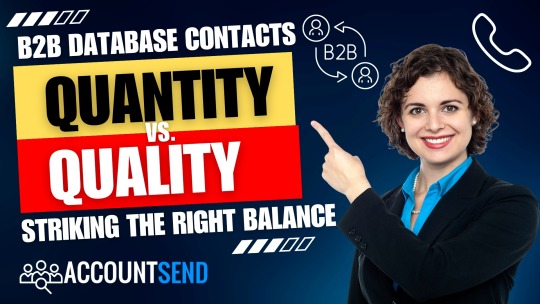
In the ever-evolving landscape of B2B sales, the tapestry of effective B2B Lead Generation, targeted Sales Leads, and strategic Business Development is intricately woven with the threads of the B2B Contact Database. This comprehensive article embarks on an exploration to unravel the profound interplay between quality and quantity – the pulse that resonates within B2B Database Leads. Join us on this journey as we traverse the pathways, strategies, and insights that guide you towards mastering the equilibrium, steering your Sales Prospecting initiatives towards finesse and success.
DOWNLOAD THE INFOGRAPHIC HERE
The Essence of Quality
Quality emerges as the cornerstone in the realm of B2B Lead Generation, encapsulating the essence of depth, precision, and pertinence that envelops the contact data nestled within the B2B Contact Database. These quality leads, much like jewels in a treasure trove, possess the capacity to metamorphose into valuable clients, etching a definitive impact on your revenue stream. Every contact entry isn't a mere data point; it's a capsule that encapsulates an individual's journey – their role, industry, buying tendencies, and distinctive preferences. Cultivating a repository of such high-caliber contacts is akin to nurturing a reservoir of prospects, where each interaction holds the promise of meaningful outcomes.
Deciphering the Role of Quantity
Yet, even in the pursuit of quality, quantity emerges as a steadfast ally. Quantity embodies the expanse of contacts that populate your B2B Database Leads. Imagine casting a net wide enough to enfold diverse prospects, broadening your scope of engagement. A higher count of contacts translates to an amplified potential for interaction, heightening the probability of uncovering those latent prospects whose untapped potential can blossom into prosperous business alliances. However, it's imperative to acknowledge that quantity, devoid of quality, risks transforming into an exercise in futility – a drain on resources without yielding substantial outcomes.
Quality vs. Quantity: The Artful Balancing Act
In the fervor of database compilation, the allure of sheer quantity can occasionally overshadow the crux of strategic B2B Sales and Sales Prospecting. An extensive, indiscriminate list of contacts can rapidly devolve into a resource drain, sapping efforts and diluting the efficacy of your marketing endeavors. Conversely, an overemphasis on quality might inadvertently curtail your outreach, constraining the potential for growth. The true artistry lies in achieving a symphony – a realization that true success unfolds from the harmonious interaction of quality and quantity.
youtube
Navigating the Equilibrium
This path towards equilibrium demands a continual commitment to vigilance and meticulous recalibration. Consistent audits of your B2B Contact Database serve as the bedrock for maintaining data that is not only up-to-date but also actionable. Removing outdated, duplicated, or erroneous entries becomes a proactive stride towards upholding quality. Simultaneously, infusing your database with fresh, relevant contacts injects vibrancy into your outreach endeavors, widening the avenues for engagement and exploration.
Harnessing Technology for Exemplary Data Management
In this era of technological prowess, an array of tools stands ready to facilitate the intricate choreography between quality and quantity. Step forward Customer Relationship Management (CRM) software – an invaluable ally empowered with features such as data validation, deduplication, and enrichment. Automation, the pinnacle of technological innovation, elevates database management to unparalleled heights of precision, scalability, and efficiency. Embracing these technological marvels forms the bedrock of your B2B Sales and Business Development strategies.
Collaborating with Esteemed B2B Data Providers
In your pursuit of B2B Database Leads, consider forging collaborations with esteemed B2B data providers. These seasoned professionals unlock a treasure trove of verified leads, tailor-made solutions for niche industries, and a portal to global business expansion. By tapping into their expertise, you merge the realms of quality and quantity, securing a comprehensive toolkit poised to reshape your sales landscape.
As we draw the curtains on this exploration, remember that the compass steering your B2B Sales, Sales Prospecting, and Business Development endeavors is calibrated by the delicate interplay of quality and quantity. A B2B Contact Database enriched with high-value leads, accompanied by a robust quantity, stands as the axis upon which your strategic maneuvers pivot. Equipped with insights, tools, and allies like AccountSend, your pursuit to strike this harmonious equilibrium transforms into an enlightening journey that propels your business towards enduring growth and undeniable success.
#AccountSend#B2BLeadGeneration#B2B#LeadGeneration#B2BSales#SalesLeads#B2BDatabases#BusinessDevelopment#SalesFunnel#SalesProspecting#BusinessOwner#Youtube
14 notes
·
View notes
Text
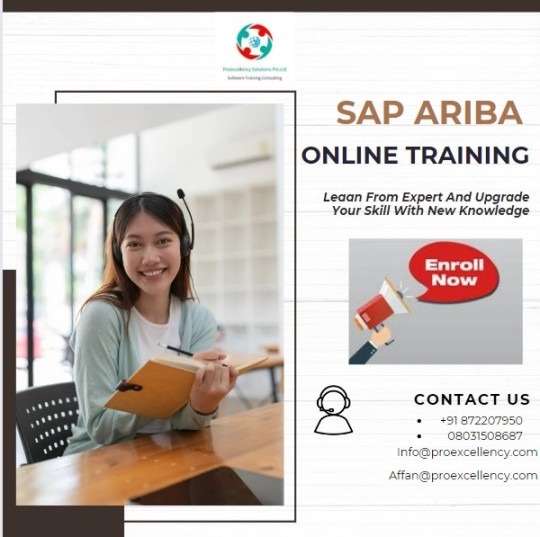
Unlock SAP Ariba's potential with online training! Proexcellency offers flexible, cost-effective courses led by expert instructors. Gain hands-on experience, explore case studies, and prepare for certifications. Master supplier management, sourcing, purchasing, invoicing, and analytics. Advanced modules cover customization, integration, analytics, and compliance. Invest for reduced costs, increased efficiency, data control, and supplier relationships. Stay competitive with digital procurement. Start your SAP Ariba journey with Proexcellency now! 🌐 [Explore courses](insert link) | 📞 +91 8722079509 | 📧 [email protected] |
2 notes
·
View notes
Text
⏱️ Mastering Time Management with SAP: A Path to Efficiency ⏱️
In today's fast-paced business world, effective time management is a precious asset. Dive into the realm of SAP, where SAP FS-CD (Collections and Disbursements) emerges as a powerful tool to enhance your time management skills. Visit Noshtek.com SAP consultant in US/USA to explore how their solutions complement SAP and can help your organization excel in computing on the cloud, analytics for finance, and human capital management.
SAP: The Engine of Business Efficiency
SAP's role in streamlining operations.
SAP FS-CD's impact on financial asset management.
SAP FS-CD: Your Time-Saving Companion
This module is designed for collections and disbursements, providing automation, real-time data access, robust reporting, and customization to boost your efficiency.
Maximize Your Time Management
Invest in training and skill development.
Explore integration with automation tools.
Keep an eye on efficiency metrics within SAP FS-CD.
Elevate Your Time Management: Explore More
Unlock the potential of efficient time management with SAP FS-CD and experience a significant boost in productivity and effectiveness in your professional journey.
3 notes
·
View notes
Text
Top SAP MM Consultant Interview Questions: Prepare for Success
What is the scope of SAP MM?
The scope of SAP MM (Materials Management) is quite extensive, covering a wide range of procurement and inventory management processes within an organization. Here are the key areas that fall under the scope of SAP MM:
Material Master Data: SAP MM encompasses the management of material master data, which includes details about materials, such as descriptions, classifications, storage locations, and purchasing information.
Procurement Processes: SAP MM covers various procurement processes, including purchase requisitions, purchase orders, request for quotations, vendor evaluation, and contract management. It ensures smooth and efficient procurement of goods and services.
Inventory Management: SAP MM facilitates effective management of inventory, including stock monitoring, goods receipts, goods issues, stock transfers, physical inventory, and stock valuation.
Warehouse Management: SAP MM integrates with SAP Warehouse Management (WM) module to handle warehouse operations, such as inbound and outbound processes, storage bin management, and inventory control.
Invoice Verification: SAP MM includes functionalities for invoice verification, which involves comparing vendor invoices with purchase orders and goods receipts to ensure accuracy and initiate payment processing.
Material Requirement Planning (MRP): SAP MM supports MRP processes, which involve determining the materials and quantities required to fulfill production or customer demands, and generating procurement proposals accordingly.
Introduction: (sap mm consultant interview questions)
If you’re aspiring to become an SAP MM (Materials Management) consultant or have an upcoming interview for this role, it’s essential to be well-prepared. SAP MM consultants play a vital role in managing the procurement and inventory processes within an organization. To help you ace your interview, we’ve compiled a list of informative and common SAP MM consultant interview questions, along with some valuable insights and tips.
Question: What is the purpose of the SAP MM module, and what functionalities does it encompass?
Answer: The SAP MM (Materials Management) module focuses on managing the procurement and inventory processes within an organization. Its functionalities include material master data management, purchase requisitions, purchase orders, goods receipt, invoice verification, inventory management, and vendor management.
Question: How do you handle material master data in SAP MM, and why is it important?
Answer: Material master data in SAP MM is managed through the Material Master record. It contains detailed information about materials, such as descriptions, procurement details, storage locations, and accounting data. Accurate and up-to-date material master data is crucial for efficient procurement, inventory management, and reporting processes. It ensures that the right materials are available at the right time and at optimal costs.
Question: Can you explain the different types of procurement processes in SAP MM?
Answer: In SAP MM, the different types of procurement processes include:
Purchase Requisition (PR): A request to procure materials or services.
Request for Quotation (RFQ): Inviting suppliers to submit quotations for materials or services.
Purchase Order (PO): An official document to procure materials or services from a vendor.
Goods Receipt (GR): Recording the receipt of materials into inventory.
Invoice Verification: Verifying vendor invoices against purchase orders and goods receipts.
Question: How do you define a source list in SAP MM, and how is it used in the procurement process?
Answer: A source list in SAP MM is a list of approved vendors for a material. It helps ensure that only specific vendors are selected during the procurement process. The source list is maintained at the plant level and specifies the validity dates for each vendor. This helps control the procurement process and maintain consistent quality and pricing from approved vendors.
Question: Can you explain the difference between a purchase requisition and a purchase order in SAP MM?
Answer: A purchase requisition (PR) is an internal document that is used to request the procurement of materials or services. It initiates the procurement process. On the other hand, a purchase order (PO) is an official document issued to a vendor to procure materials or services. A PR is a request, while a PO is a formal commitment to purchase.
Question: How do you handle the subcontracting process in SAP MM?
Answer: The subcontracting process in SAP MM involves sending materials to a subcontractor for processing or assembly. Here are the key steps:
Create a subcontracting purchase requisition.
Convert the purchase requisition into a subcontracting purchase order.
Transfer the materials to the subcontractor using a goods issue.
Receive the processed or assembled materials using a goods receipt.
Perform invoice verification for the subcontracting services provided.
Question: How do you perform inventory management in SAP MM?
Answer: Inventory management in SAP MM involves tracking and controlling materials within the organization. Key activities include:
Goods Receipt: Recording the receipt of materials into inventory from vendors or other sources.
Goods Issue: Issuing materials from inventory for internal consumption or external use.
Stock Transfer: Transferring materials between different storage locations or plants.
Stock Adjustment: Adjusting inventory quantities due to physical inventory counts or other reasons.
Stock Valuation: Valuing inventory using various methods, such as moving average price or standard price.
Question: Can you explain the concept of a release strategy in SAP MM?
Answer: A release strategy in SAP MM defines the approval process for purchase requisitions and purchase orders based on predefined criteria, such as the value of the document or the purchasing organization. It ensures that the appropriate individuals or departments review and approve procurement documents before they are finalized and sent to vendors. Release strategies help maintain control and adhere to internal authorization requirements.
Question: How do you handle pricing conditions in SAP MM?
Answer: Pricing conditions in SAP MM determine the cost or price of materials during procurement. They include elements like base prices, discounts, surcharges, and taxes. Pricing conditions are maintained in condition records and can be automatically determined based on factors such as the vendor, material, quantity, or purchasing organization. The pricing procedure in SAP MM determines the sequence and logic for pricing condition determination.
Question: How do you handle vendor evaluation and selection in SAP MM?
Answer: Vendor evaluation in SAP MM is performed to assess and select the most suitable vendors based on criteria such as quality, delivery performance, and price. The evaluation can be based on subjective assessments or objective measures, such as on-time delivery percentages or defect rates. The results of vendor evaluation can be used to negotiate better terms, maintain a preferred vendor list, and improve overall procurement processes.
Question: How do you handle the process of invoice verification in SAP MM?
Answer: Invoice verification in SAP MM involves matching the vendor’s invoice with the purchase order and goods receipt to ensure accuracy and validity. The process includes:
Verifying that the invoice matches the purchase order and goods receipt.
Checking for any discrepancies or variances in quantities, prices, or terms.
Resolving any issues or discrepancies with the vendor.
Posting the invoice for payment processing in SAP FI (Financial Accounting).
Question: How do you handle stock valuation in SAP MM?
Answer: Stock valuation in SAP MM determines the monetary value of inventory items in the system. It can be done using various methods, such as moving average price or standard price. Moving average price calculates the average cost based on the goods received, while standard price uses a predetermined cost for valuation. Valuation is essential for accurate financial reporting and inventory control.
Question: Can you explain the concept of consignment in SAP MM?
Answer: Consignment in SAP MM refers to a scenario where a vendor’s materials are stored at the customer’s premises, but the ownership of the materials remains with the vendor until they are consumed. The customer only pays for the materials when they are actually used. Consignment stock is tracked separately in SAP MM, and the vendor’s liability is settled based on the consumption of the materials.
Question: How do you handle the integration between SAP MM and SAP SD (Sales and Distribution)?
Answer: Integration between SAP MM and SAP SD enables seamless flow of information and processes. Key integration points include:
Material Master Data: Materials created in SAP MM are used for sales order processing in SAP SD.
Availability Check: SAP SD checks the availability of materials in SAP MM to determine if the requested quantities can be delivered.
Delivery Processing: Deliveries in SAP SD trigger goods issue postings in SAP MM for inventory reduction.
Billing: Billing documents in SAP SD generate accounting entries for revenue recognition and financial reporting.
Question: How do you handle inventory optimization in SAP MM?
Answer: Inventory optimization in SAP MM involves maintaining optimal inventory levels to meet demand while minimizing excess stock. Some approaches to inventory optimization include:
Forecasting and Demand Planning: Using historical data and demand forecasts to predict future material requirements.
ABC Analysis: Classifying materials based on their consumption value to prioritize inventory management efforts.
Reorder Point Planning: Setting minimum stock levels that trigger replenishment to avoid stockouts.
Just-in-Time (JIT) Procurement: Aligning material procurement with production or customer demand to reduce inventory holding costs.
Question: How do you handle the process of subcontracting in SAP MM?
Answer: Subcontracting in SAP MM involves outsourcing certain operations or processes to a subcontractor. Here are the key steps:
Create a subcontracting purchase requisition.
Convert the purchase requisition into a subcontracting purchase order.
Transfer the components to the subcontractor using a goods issue.
Receive the finished or processed goods using a goods receipt.
Perform invoice verification for the subcontracting services provided.
Question: How do you handle the process of physical inventory in SAP MM?
Answer: Physical inventory in SAP MM involves conducting periodic stock counts to verify the accuracy of inventory quantities. Key steps include:
Planning and scheduling the physical inventory count.
Performing the physical count and recording the actual quantities.
Comparing the actual quantities with the system quantities.
Resolving any discrepancies or variances.
Adjusting the inventory quantities based on the findings.
Question: Can you explain the concept of batch management in SAP MM?
Answer: Batch management in SAP MM involves tracking and managing materials that are produced or procured in batches. Each batch is assigned a unique identification number and can be traced throughout the entire supply chain. Batch management is crucial for industries where product traceability, quality control, and shelf-life management are essential, such as pharmaceuticals and food manufacturing.
Question: How do you handle the process of vendor evaluation in SAP MM?
Answer: Vendor evaluation in SAP MM is performed to assess and rate vendors based on various criteria, such as quality, delivery performance, service level, and price competitiveness. The evaluation process typically involves creating evaluation questionnaires, collecting feedback from relevant stakeholders, analyzing the results, and generating vendor performance reports. The evaluation results help in making informed decisions regarding vendor selection and improvement initiatives.
Question: How do you handle the integration between SAP MM and SAP FI (Financial Accounting)?
Answer: Integration between SAP MM and SAP FI ensures the seamless flow of financial information related to procurement and inventory management. Key integration points include:
Goods Receipt: Goods receipts in SAP MM trigger accounting postings in SAP FI for inventory valuation and cost recognition.
Invoice Verification: Verified invoices in SAP MM generate accounting entries in SAP FI for expense recognition and liability settlement.
Asset Management: SAP MM provides information on fixed assets, which is integrated with SAP FI for asset accounting and depreciation.
Conclusion: (sap mm consultant interview questions)
Preparing for an SAP MM consultant interview requires a solid understanding of the module’s key concepts and processes. By familiarizing yourself with these interview questions and their insights, you’ll be well-equipped to showcase your knowledge, skills, and practical experience. Remember to supplement your theoretical understanding with real-world examples and demonstrate your ability to apply SAP MM principles in practical scenarios. Best of luck with your SAP MM consultant interview!(sap mm consultant interview questions)
2 notes
·
View notes